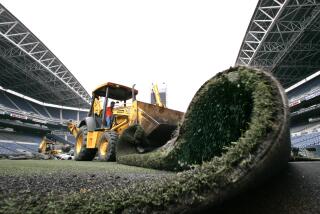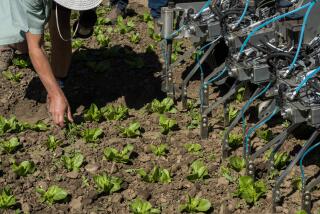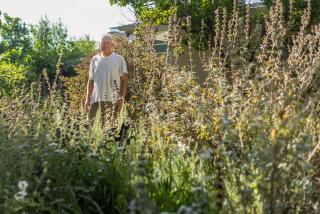It’s time once again for the paring o’ the green.
- Share via
It was a ‘60s-something Cooper Klipper--one of the last of the back-throw lawn mowers--protruding from the trunk of Joe Blau’s root-beer-colored Camry. Blau was slowly steering through an industrial park, searching for the service entrance of Los Alamitos Mower & Saw.
Blau didn’t need to read the sign to know he had reached the right place. A couple of dozen other mowers of various vintages and conditions were huddled in the parking lot. Some were crusted with grass and dirt, some infected with rust, others as clean as clocks. Each featured a fluttering tag for service or repair.
“I’d kind of hoped I could just get in and out,” sighed Blau, 62, in a T-shirt, Bermuda shorts and hard shoes.
He loosened the clean, white ropes that had secured his old red mower during the drive from Buena Park. “I’d kind of planned to get home in time to mow my lawn today.”
Perfectly normal, those hopes and plans, because this is lawn-mowing season. Pretty unlikely, however, for the very same reason.
“There’s about a week-and-a-half wait before we can get to anything,” said Roger Williams, who owns Los Alamitos Mower & Saw, speaking with polite, well-practiced firmness intended to cut off any negotiation. “People who came in a couple of months ago when it was slow could get their mowers back in a day or so, no matter what was wrong.”
But now it’s lawn-mowing season.
Anybody in Orange County with dominion over a patch of grass is apt to be pacing back and forth across it, marching to the machine-gun beat of a 3 1/2-horsepower drummer, mesmerized by the baton twirl of sharpened blades, following their lawn mowers toward the vision of a pristine green carpet.
Or paying someone else to do it.
“I cut my lawn myself, every two weeks, and I keep it properly fertilized,” Blau said in the singsong of a long-practiced habit. “I’m a do-it-yourselfer, the old-fashioned kind, I guess you could say.”
A manicured lawn is such a part of the inhabited landscape that its presence and function are rarely questioned.
But in “The Lawn: A History of an American Obsession” (Smithsonian Institute Press), author Virginia S. Jenkins attributes its development to a variety of aesthetic, social and economic forces.
Historically, Jenkins notes, lawns appeared in England and France in the 18th century as aspects of grand gardens. They began to surround single-family houses in the United States after the Civil War--about the time the first American lawn mowers were patented. But it wasn’t until after World War II, propelled by government-financed suburban development, that the lawn massively proliferated.
“The suburban lawn seems to be an attempt to preserve some semblance of our agrarian heritage,” said Michael Steiner, who chairs the American-studies department at Cal State Fullerton. “Tilling and seeding and managing a plot of land is still important to Americans’ definition of themselves.”
And sure enough, as Steiner spoke, his wife, Lucy, was working the frontyard soil of their ranch-style Fullerton house, which is home to a very nice lawn.
Shoppers in the lawn and garden department at the HomeBase store in Stanton tended to agree, sounding a lot like yeoman farmers and naturalist philosophers as they described the challenges of urban landscaping.
“I’ve been fighting a batch of gophers, which just plays havoc with everything I’m trying to do, from the grass to the flowers,” lamented Virginia Smith of Garden Grove. “But you do get the good with the bad, and I’ve also got a nest of birds in a tree. It’s nice to hear them chirping away.”
Mitch Tawson of Anaheim was pushing a cart piled high with bags of seed and sod, getting ready to reclaim part of his land for a lawn as part of a rite of passage for his 10-year-old son.
“He needs a lawn to mow,” said Tawson, who was removing an area he had previously covered with artificial turf. “Mowing the lawn teaches responsibility and a respect for nature. That’s what it did for me, anyway.”
Smith, who was born on a Kansas farm, leaves the lawn-mowing to a gardener--a more and more common practice in pressed-for-time households, although that’s not her reason.
“I just turned 76 and I’m not going to push a lawn mower anymore, thank you,” she said, laughing.
Smith still supervises, however. “I’ve been having it mowed every other week till now, but what with the warmer weather I’m about to step it up to once a week.”
In other areas of the country, the arrival of lawn-mowing season is part of a general spring revival. That’s not necessarily so in Orange County. Spring showed up here in March the way it usually does--noticed mostly by those who read the fine print on the calendar, about as meaningful as the street signs that separate one suburb from another.
There had already been a summerlike heat wave. Lawn-mowing season was already in full swing.
“Lawn-mowing season starts with the first good sun after the winter rains, whenever that is,” says Kay Fukumoto, 56, who repairs lawn mowers at Kent’s Lawn Mower Shop, a business she and her husband operate in Costa Mesa.
“This year, January was kind of busy, then it got slow in February when it rained again, then it really picked up in early March when we had that heat wave.”
The unpredictability of lawn-mowing season is exceeded only by the persnickety nature of mowers.
After a period of disuse, lots of them don’t immediately respond to the first few pulls on their starter cords. Others refuse altogether, especially if they’ve been stored with gas in the tank, which coagulates in the fuel lines.
When mechanical obstinacy thwarts man’s imperious urge to mow the lawn, the atmosphere at the ol’ mower shop can get kind of agitated.
“People go bananas,” said Dale Kenny, 52, of Don’s Lawn Mower Shop in Santa Ana. “They come out of the woodwork with lawn mowers that have been sitting around--sometimes outside--for months. And everybody wants the work done yesterday.”
Kenny is used to it. He’s run the business for 20 years and his father founded Don’s Lawn Mower Shop in 1955.
“When it comes to lawn-mowing season, nobody ever thinks ahead. They never have,” he said. “They’ve always got their golf clubs all polished up, ready to go, but they expect the lawn mower will be ready when they pull it out.”
That’s been Blau’s experience with his trusty Cooper Klipper, which has been worked so hard and long that its rubber tires are worn away and some pieces are held together by black electrical tape.
“But I’ve always kept it clean and freshly oiled, so I’ve brought it in for service twice--and one of those times was to get the blades sharpened,” he said proudly. “I paid $169 for this machine almost 30 years ago. It was a good one at that time, and I guess it still is. It still mows the lawn.”
(BEGIN TEXT OF INFOBOX / INFOGRAPHIC)
Tips to Help Cut Mowing Problems * A watered lawn grows faster; water less, mow less.
* Don’t mow too low. Grass needs its leaves to produce food. The ideal height for most grasses is 2 1/2 to 3 inches in hot weather and a half-inch shorter in cool weather. Remove only one-third of the blades’ length at a time.
* A mown height of 2 1/2 inches for a mixed-grass green to 3 1/2 inches for tall fescues is appropriate. A taller lawn won’t just save labor and gasoline but saves the lawn itself, shading the roots, preserving moisture, keeping it healthier.
* If grass tips turn white after you’ve mowed, mower blades probably need sharpening. Rotary blades should be honed monthly, reel-types annually.
* If the grass is badly overgrown, mow it twice, three or four days apart. Clippings less than 1 inch long may be left on the ground. Rake longer clippings for the compost pile.






